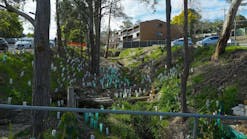Digging for Durability
About the author: Anthony Bertolini is product specialist for Heavyweight Sediment Control Solutions. Bertolini can be reached at [email protected].
Building new residential communities on undeveloped land creates major risks to downstream environments. In Kentucky and Indiana, precipitation rates average between 40 and 50 in. per year. This high level of precipitation, coupled with thousands of acres of disturbed soil, can create erosion and pollution problems for even the most experienced environmental manager.
Working With Wattles
Jagoe Homes is a home builder that installs and maintains erosion prevention and sediment control measures at home developments under construction. In the past, it has installed silt fence as the main perimeter control device at its home sites and developments under construction. However, in one application, silt fence was a struggle for their in-house installation team.
“We had a hard time properly maintaining [the installed silt fence] after heavy rain events,” said Brad Jagoe, vice president of operations for Jagoe Homes. “The silt fence was also regularly damaged at site entrances when materials were delivered.”
On average, the silt fence installed at a development would require replacement three to four times before stabilization, due to heavy concentrated runoff and damage from subcontractors delivering materials. The team tried to use weighted synthetic sediment barriers as an alternative to the failing silt fence. These barriers were secured by the weight of their filter media-usually crumb rubber-and were designed with handles for convenient transport and installation. Although the weighted barriers were more durable than silt fence, they proved difficult to manage after rain events.
“With the weighted sediment tubes, they were good at the beginning, but they were tough to handle and maintain,” Jagoe said. “They were tough on the backs of the people having to move them. The longer they were in place, the more sediment they retained and the heavier they became.”
The extra time and effort maintaining the weighted sediment barriers outweighed the added benefits. After four years of sediment control struggles, an alternative best management practice (BMP) was needed. Durability was a top priority. The BMP would need to be lightweight and low-maintenance. It had to be durable enough to be installed around site entrances and withstand heavy traffic from subcontractors. Most importantly, the sites needed to be in compliance. Protecting the environment surrounding the communities and maintaining good relationships with local inspectors were high priorities.
A skid-steer loader was sometimes used to backfill soil during installation.
Synthetic Solutions
Jagoe Homes decided to use DuraWattle as a low-maintenance solution to its sediment control challenge. DuraWattle is a synthetic sediment retention device that does not absorb sediment; the outer layer of filter fabric dissipates concentrated flow and dewaters sites, while the non-permeable core traps sediment behind the barrier. Jagoe Homes decided to use the product as the main perimeter control device on the street facing side of several communities under construction in Kentucky and to be used for the life of each development project, from initial groundwork to the final grading before sod was installed.
The product arrived compressed as 1,800 ft of product per pallet. The compressed bundles, composed of 300 ft of product per bundle, were loaded by hand onto trucks and sent out for installation. The installation went quickly. The in-house installation team installed approximately 2,000 ft per day using picks and shovels to trench. Hammers and nails were used to secure the tail section of each wattle to the installation surface. In some cases, a skid-steer loader was used to expedite the backfilling of soil over the tail section of the product.
Long-Term Savings
On Jagoe Homes development sites, the synthetic wattles have lasted long and took little effort to maintain. The installed product has required little replacement; only routine sediment removal has been required after rain events. The design has kept site entrances in compliance, and material deliveries no longer cause BMP failures. Less than 5% of the installed wattles have been damaged by heavy traffic and required replacement, Jagoe said.
The product has been easy to remove from sites, and Jagoe Homes has reused more than 80% of its original purchase from 2016. It is stored at concrete washouts or stockpile areas of each new development site. Jagoe has reported major labor cost savings. And notably, the streets of the developments are clean.
The barrier could be driven over without flattening.






